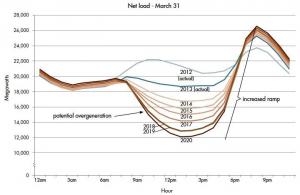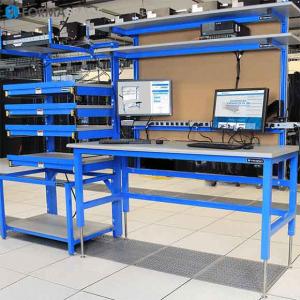
Micro Nuclear Power Plants Are Set to See the Light of Day

The custom U-shaped computer workbench shown above is a popular choice for Network Engineers, Systems Administrators, Web Developers, and Network Technicians.
Are micro nuclear plants the cure for looming power shortages created by artificial intelligence? We investigate in this Formaspace executive report.
Artificial Intelligence systems may be powerful, but they are also power-hungry.
A statistical claim by analysts at the International Energy Agency summarizes the situation:
"One ChatGPT Internet Search Uses Ten Times The Amount Of Energy As A Normal (E.G. Pre-AI) Google Search."
With AI-based technology expected to become a leading economic growth engine, both software companies and the energy industry are scrambling to source enough electric power to run the data centers that will host their AI applications.
How much more power will be needed?
In Texas, the electric grid regulator, ERCOT, shocked state officials when they unexpectedly raised their electricity demand forecasts to 150,000 mega watts (MW) by 2030 – a 276% increase over today’s 85,000 MW baseline – due primarily to the high demand for electricity created by AI and crypto-mining operations opening up in the state.
Goldman Sachs energy analysts predict that thanks in large part to AI, domestic data centers will consume 8% of US power output by 2030, up from 3% in 2022. Goldman also estimates that worldwide data center energy use will spike 160% by 2030 – leading to increased carbon dioxide emissions representing a “social cost” burden of between $125 and 140 billion.
Solar And Wind Have Limitations. In The Eyes Of Tech Investors, Mini Nuclear Power Plants Might Be The Right Fit
AI-focused tech companies recognize energy is a major problem.
The cost of building a bigger energy infrastructure and the risk of increasing greenhouse gas emissions could result in new regulations that threaten to take their golden goose eggs away.
The race is on to find a solution.
Reducing The Energy Use Of AI Hardware Could Help.
At GTC 2024, Nvidia introduced their next-generation Blackwell GPUs, which they claim are 25 times more energy-efficient for AI processing.
Nevertheless, AI tech companies are looking to invest in new green energy technologies, including smaller next-generation nuclear power plants, to solve the problem.
Why nuclear?
Renewables such as solar and wind are increasingly important energy sources to power the grid, but they only produce power during the day or when the wind blows (respectively), creating what power engineers call the “duck curve” – due to its distinctive overproduction curve during the day and rapid drop off during the evening hours.
Energy storage batteries can (and increasingly do) store the excess energy produced by solar and wind, but in many cases, the electric grid needs to be upgraded to support bigger electric backup systems.
A lack of confidence in whether utilities can upgrade the grid quickly enough to meet skyrocketing demand for electricity may be the underlying reason many tech executives are eyeing investments in next-generation mini nuclear power plants.
If companies can get them to work successfully (and safely), mini nuclear power plants would allow AI data centers to bypass the grid entirely to tap into a power source that runs 24×7 without producing large amounts of greenhouse gases.
Who Is Funding The Development Of Small Modular Reactors (SMRs) And Micro Reactors – And When Could They Come Online?
In 2020, the DOE’s Office of Nuclear Energy announced it was funding ten nuclear power research projects through its Advanced Reactor Development Program. Subsequently, the DOE allocated $4.6 billion in funding (through 2030) for three nuclear commercialization projects:
$1.4 billion over 10 years for the Carbon Free Power Project, a small modular reactor (SMR) developed by NuScale Power, located on DOE’s Idaho National Laboratory Site. Power production is expected to commence in December 2029.
$2 billion to TerraPower to complete the Natrium™ Demonstration Reactor in Wyoming by 2028. It uses metal oxide fuel in a fast neutron reactor, cooled by a liquid sodium molten salt energy storage system that can retain heat to provide additional surge power for over 5 ½ hours.
$1.2 billion to X-energy to complete the Xe-100 Demonstration in Washington State by 2027. The advanced small modular reactor is made of graphite, powered by sealed, billiard-ball-sized uranium-enriched fuel “pebbles.”
But government funding only goes so far.
Private Investors And Public Power Utilities Will Have To Match (Or Exceed) The Federal Government’s $1.46 Billion Contribution To The Three Projects Listed Above.
For example, investors in TerraPower’s Natrium Demonstration Reactor, which includes Bill Gates (an outspoken advocate of next-generation nuclear power) will match the Fed’s $1.46 billion funding allocation.
Other tech billionaires are on board as well.
For example, Sam Altman, the CEO of OpenAI (of ChatGPT fame) is joining Microsoft to back the nuclear fusion company Helion. Scientists at Helion’s research and development laboratories in Everett, Washington (outside of Seattle) are developing a magnetized vacuum chamber to generate fusion energy from the helium-3 isotope. If successful, they plan to deploy their first production power plant in rural Chelan County, Washington.
The government is taking the advances in mini nuclear power seriously.
Read more...
Julia Solodovnikova
Formaspace
+1 800-251-1505
email us here
Visit us on social media:
Facebook
X
LinkedIn
EIN Presswire does not exercise editorial control over third-party content provided, uploaded, published, or distributed by users of EIN Presswire. We are a distributor, not a publisher, of 3rd party content. Such content may contain the views, opinions, statements, offers, and other material of the respective users, suppliers, participants, or authors.



